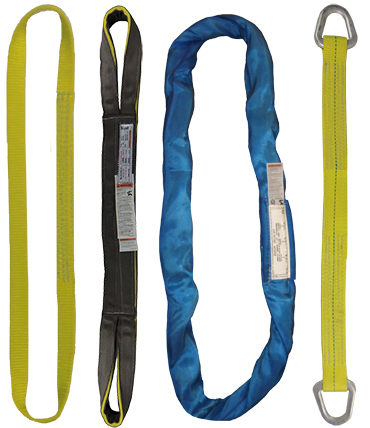Synthetic Slings – Qualities and Traits
Synthetic Slings – Qualities and Traits
 Synthetic slings offer excellent load protection. Unlike other sling types, they generally do not mar or scratch machined surfaces. They are equally suited for use on expensive loads, highly finished parts, and delicate surfaces or equipment. Care should be taken to insure that no foreign materials, which may induce scratches or other damage, are present in the sling body.
Synthetic slings offer excellent load protection. Unlike other sling types, they generally do not mar or scratch machined surfaces. They are equally suited for use on expensive loads, highly finished parts, and delicate surfaces or equipment. Care should be taken to insure that no foreign materials, which may induce scratches or other damage, are present in the sling body.
Benefits
-
Strength – can handle a load of up to 300,000 lbs.
-
Convenience – can conform to any shape
-
Safety – will adjust to the load contour and hold it with a tight, non-slip grip
-
Load protection – will not mar, deface, or scratch highly polished or delicate surfaces.
-
Long life – they are unaffected by mildew, rot or bacteria
-
Economy – have a low initial cost plus a long service life
-
Shock absorbent – they can absorb heavy shocks without damage
-
Temperature resistant – are unaffected by temperatures up to 180 degree fahrenheit
Care and Usage
-
Protect from sharp edges – slings must be protected over cover saddles, burlap padding, or wood blocking as well as anything that has sharp bends or cutting edges.
-
Properly secure load – if slings are dragged on the ground or other surfaces it could damage it.
-
Set sling accurately – when positioning the sling, it should sit squarely within the hook bowl. This provides maximum lifting efficiency without stressing the sling.
Removal Criteria
Web slings should be removed from service if any of the following are present:
-
Acid or caustic burns,
-
Melting or charring of any part of the sling surface,
-
Snags, punctures, tears or cuts,
-
Broken or worn stitches,
-
Distortion, wear or fracture of fittings, and
-
Other apparent defects which cause doubt as to the strength of the sling should be referred to the Manufacturer for determination.
Our parent company, WiscoLift, Inc., offers online Web Sling Inspection training and certificate. For more information, please call us at 800-242-3477 or email smartlift@wiscolift.com.
High Quality Every Time.
 Synthetic slings offer excellent load protection. Unlike other sling types, they generally do not mar or scratch machined surfaces. They are equally suited for use on expensive loads, highly finished parts, and delicate surfaces or equipment. Care should be taken to insure that no foreign materials, which may induce scratches or other damage, are present in the sling body.
Synthetic slings offer excellent load protection. Unlike other sling types, they generally do not mar or scratch machined surfaces. They are equally suited for use on expensive loads, highly finished parts, and delicate surfaces or equipment. Care should be taken to insure that no foreign materials, which may induce scratches or other damage, are present in the sling body.
